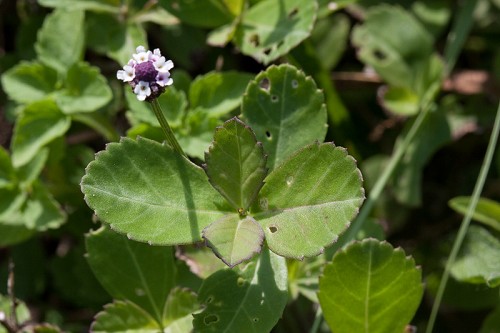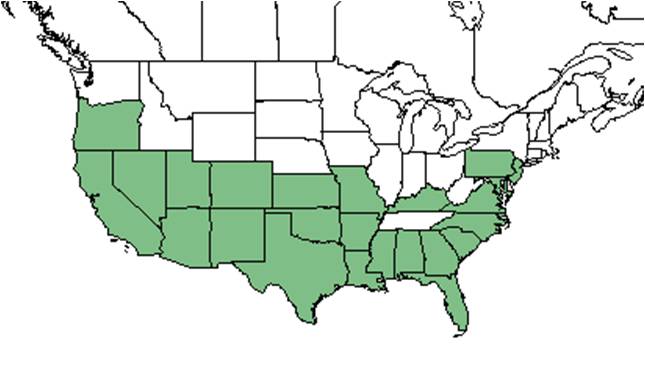Difference between revisions of "Phyla nodiflora"
(→References and notes) |
(→Photo Gallery) |
||
| Line 54: | Line 54: | ||
==Cultivation and restoration== | ==Cultivation and restoration== | ||
==Photo Gallery== | ==Photo Gallery== | ||
| + | <gallery widths=180px> | ||
| + | </gallery> | ||
| + | |||
==References and notes== | ==References and notes== | ||
Deyrup, M.A. and N.D. 2015. Database of observations of Hymenoptera visitations to flowers of plants on Archbold Biological Station, Florida, USA. | Deyrup, M.A. and N.D. 2015. Database of observations of Hymenoptera visitations to flowers of plants on Archbold Biological Station, Florida, USA. | ||
Revision as of 20:12, 16 February 2016
| Phyla nodiflora | |
|---|---|

| |
| Photo by John R. Gwaltney, Southeastern Flora.com | |
| Scientific classification | |
| Kingdom: | Plantae |
| Division: | Magnoliophyta - Flowering plants |
| Class: | Magnoliopsida – Dicotyledons |
| Order: | Lamiales |
| Family: | Verbenaceae |
| Genus: | Phyla |
| Species: | P. nodiflora |
| Binomial name | |
| Phyla nodiflora (L.) Greene | |

| |
| Natural range of Phyla nodiflora from USDA NRCS Plants Database. | |
Common name: turkey tangle fogfruit
Contents
Taxonomic notes
Description
"Appressed pubescent, prostate to ascending or decumbent, perennial herbs, rooting at the nodes, obscurely to definitely 4- angled. Leaves opposite, serrate, base cuneate to attenuate; petioles to 0.5 mm long, often obscured by decurrent blade tissue. Inflorescence a bracteate head, in fruit a spike 8-15 cm long, 5-8 mm in diam., peduncles elongate, usually at alternate nodes and rarely in both axils at a node. Sepals united near base or for ½ their length, shorter than the corolla tube and the subtending bract; corolla zygomorphic, pinkish, lavender or rarely white, salverform, ca. 3 mm long, 5-lobes less than 1 mm long; stamens included, united to the corolla tube near middle at 2 levels. Fruit a schizocarp consisting of 2 mericarps. Mericarps yellowish tan, dull, orbicular to ovoid, rounded on one side and flattened on the other, 1-1.3 mm long." - Radford et al 1964
"Stems prostrate or decumbent, rarely more than 1 dm tall. Leaves oblanceolate, obovate or elliptic, 1-3 cm long, 0.3-2 cm wide, acute, base cuneate to attenuate. Peduncles 3-10 cm long, usually 2.5X or more as long as subtending leaves." - Radford et al 1964
Distribution
Ecology
Habitat
In the Coastal Plain in Florida, P. nodiflora has been observed growing in roadside hydric seepage bogs and exposed limerock (FSU Herbarium). Associated species include Bidens, Polygonum, Cyperus and Ludwigia (FSU Herbarium).
Phenology
It has been observed flowering and fruiting in October (FSU Herbarium).
Seed dispersal
Seed bank and germination
Fire ecology
Pollination
The following Hymenoptera families and species were observed visiting flowers of Phyla nodiflora at Archbold Biological Station (Deyrup 2015):
Apidae: Apis mellifera
Halictidae: Augochloropsis metallica, Halictus poeyi, Lasioglossum lepidii
Megachilidae: Anthidium maculifrons, Coelioxys mexicana, C. texana, Megachile brevis pseudobrevis, M. mendica
Sphecidae: Ammophila urnaria, Bicyrtes insidiatrix, Prionyx thomae
Use by animals
Diseases and parasites
Conservation and Management
Cultivation and restoration
Photo Gallery
References and notes
Deyrup, M.A. and N.D. 2015. Database of observations of Hymenoptera visitations to flowers of plants on Archbold Biological Station, Florida, USA.
Florida State University Robert K. Godfrey Herbarium database. URL: http://herbarium.bio.fsu.edu. Last accessed: October 2015. Collectors: Loran C. Anderson, Robert K. Godfrey, Karen MacClendon, R.A. Norris. States and Counties: Florida: Calhoun, Franklin, Gadsden, Holmes, Leon, Liberty, Monroe, Taylor. Compiled by Tall Timbers Research Station and Land Conservancy.
Radford, Albert E., Harry E. Ahles, and C. Ritchie Bell. Manual of the Vascular Flora of the Carolinas. 1964, 1968. The University of North Carolina Press. 892-3. Print.